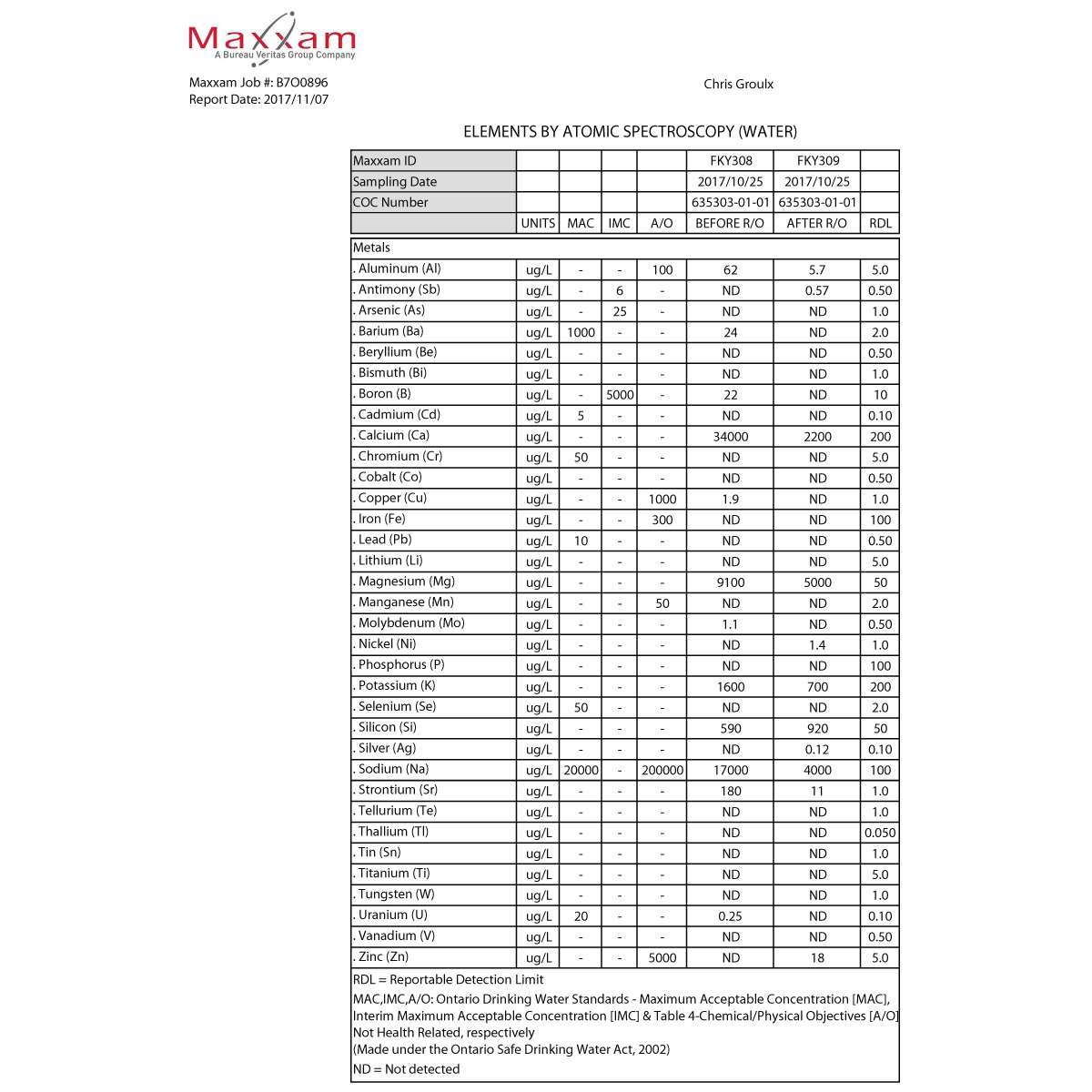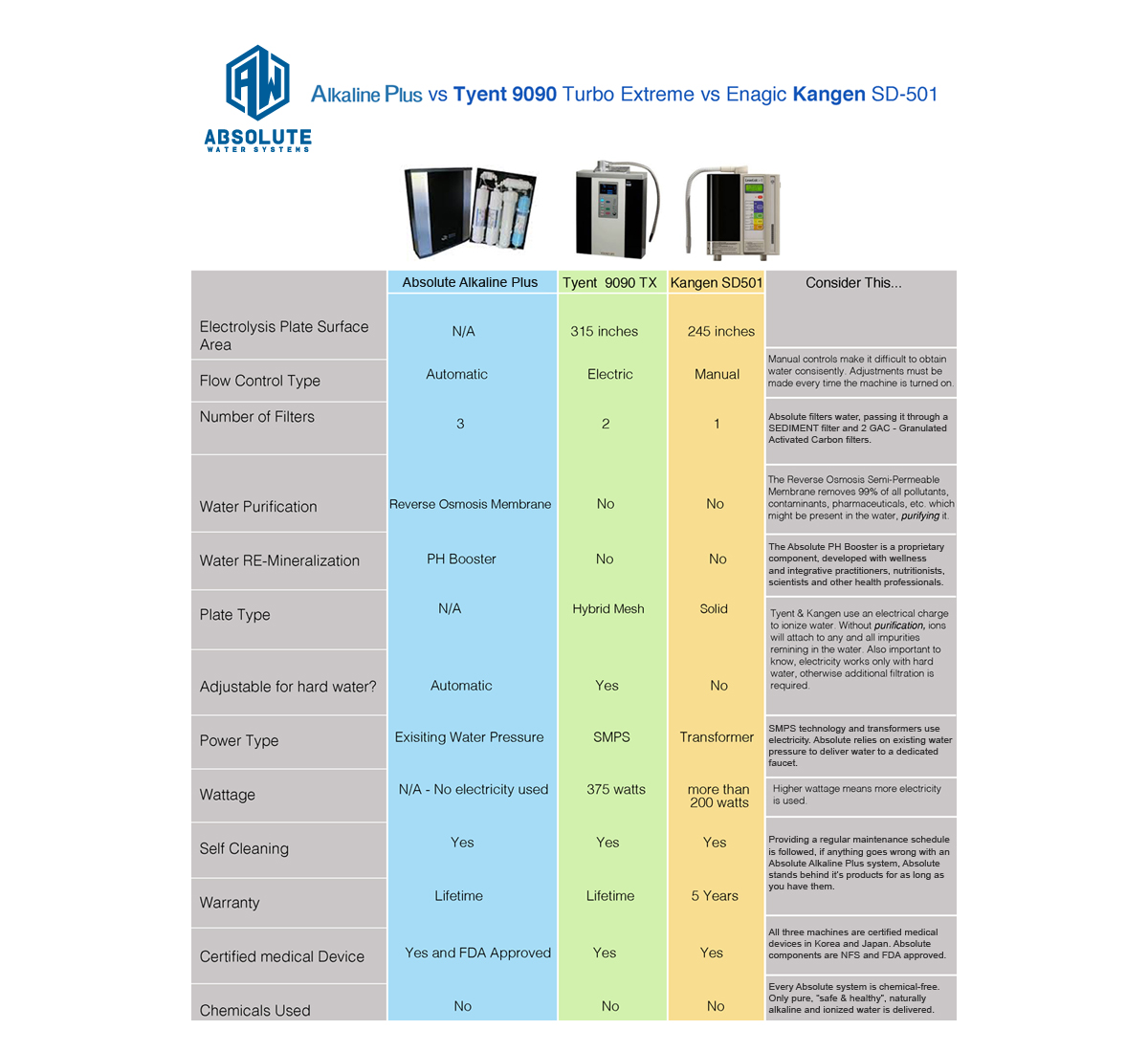RESULTS &
A BRIEF
COMPARISON
LAB TESTS & COMPARISONS
ABSOLUTE GOES ABOVE & BEYOND
When an Absolute consultant comes to your house, you will receive a free water analysis. This water analysis helps us figure out on which specific contaminants are in your water, which assures that we have the proper information needed to install the optimal components to remove them.
THE PROCESS
PUT TO THE TEST
We sent an Absolute Alkaline Plus System to an independent certified laboratory at Maaxam Analytics located in Mississauga Ont. Drinking Water Testing Laboratory, purposely contaminated water by adding numerous chemical, organic and inorganic agents at extremely high levels – so high, they're actually not found in real world scenarios.
THE STAGES
The contaminated water was filtered & purified through the 5-Stage Absolute Alkaline Plus Filtration and Purification System:
- Sediment Filter
- Granulated Carbon Filter (GAC)
- Reverse Osmosis Membrane
- Second GAC (5 micron) filter
- PH Boost cartridge to restore and elevate natural minerals which should be the only things present in water
In every instance, Absolute surpassed the test requirements for effective and complete filtration.
SUBSTANCES & IMPURITIES
THERE'S NO SUCH THING AS PURE WATER FROM NATURE
All life depends on water. In nature, water exists in many forms- clouds, rain, snow, ice, and fog; however, chemically pure water does not exist. The world's growing and expanding population has negatively impacted the quality of the earth's water. Falling as rain water picks up gases, ions, dust and other particles from the atmosphere. As it flows over the earth's surface, water picks up other impurities along the way including anything man has dumped there.
These substances may be classified as biological, chemical (both inorganic and organic), physical, and radiological impurities. They include industrial and commercial solvents, metal and acid salts, sediments, pesticides, herbicides, plant nutrients, radioactive materials, road salts, decaying animal and vegetable matter, and living microorganisms, such as algae, bacteria, and viruses. These impurities may give water a bad taste, color, odor, or cloudy appearance (turbidity), and cause hardness, corrosiveness, staining, or frothing. They may damage growing plants and transmit disease.
BIOLOGICAL SUBSTANCES
Animal and human fecal matter
Cryptosoridium
Ecoli
Giardia
Entamoeba
Toxoplasma cysts
Decaying animal matter
Decaying vegetable matter
VOCs – volatile organic compounds
CHEMICAL IMPURITIES
Chlorine
Chlorine by-products
Pharmaceuticals
Industrial runoff
Floride
Pesticides & Fertilizers
Chemical solvents
Road Salts
MTBE – a gasoline additive
ESTABLISHING PURITY & SAFETY STANDARDS
For homeowners, problems with water relate to color, odor, taste, and safety to family health. Chemists and engineers are concerned with the purity of water as it relates to scale deposition and pipe corrosion. Regulatory agencies are concerned with setting standards to protect public health. Farmers are interested in the effects of irrigation waters on the chemical, physical, and osmotic properties of soils, particularly as they influence crop production; hence, they are concerned with the water's total mineral content, proportion of sodium, or content of ions "toxic" to plant growth.
One means of establishing and assuring the purity and safety of water is to set a standard for various contaminants. A standard is a definite rule, principle, or measurement which is established by governmental authority. The fact that it has been established by authority makes a standard rigid, official, and legal; but this fact does not necessarily mean that the standard is fair or based on sound scientific knowledge. Where human health data or other scientific data are sparse, standards have sometimes been established on an interim basis until better information becomes available.
HEALTH EFFECTS OF DRINKING WATER CONTAMINANT
Chemicals in drinking water which are toxic may cause either acute or chronic health effects. An acute effect usually follows a large dose of a chemical and occurs almost immediately. Examples of acute health effects are nausea, lung irritation, skin rash, vomiting, dizziness, and, in the extreme, death.
The levels of chemicals in drinking water, however, are seldom high enough to cause acute health effects. They are more likely to cause chronic health effects, effects that occur after exposure to small amounts of a chemical over a long period. Examples of chronic health effects include cancer, birth defects, organ damage, disorders of the nervous system, and damage to the immune system.
Evidence relating chronic human health effects to specific drinking water contaminants is very limited. In the absence of exact scientific information, scientists predict the likely adverse effects of chemicals in drinking water using laboratory animal studies and, when available, human data from clinical reports and epidemiological studies.

FREE WATER ANALYSIS
The first and easy step to improve the quality of your water and life is Absolutely free.



